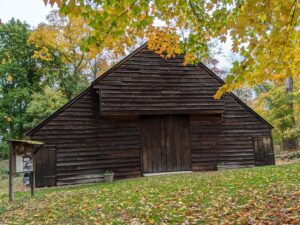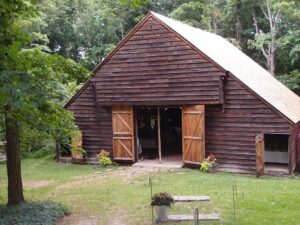The Dutch Barn

Few New World Dutch barns from the pre-Revolutionary War period survive anywhere, but Mount Gulian’s barn is one of them. Dutch barns are special because of their unique interior structures. Large wooden cross beams and horizontal columns were built in the shape of the Letter H, for structural stability but also to facilitate easy sub-dividing of the barn into smaller "pens". These smaller pens could be used to safely house small animals such as sheep, goats and poultry, to store grain and other useful plant material such as flax, to have special “drying areas” for curing hides and plants such as tobacco, and to safely store tools away from barnyard animals. Pens could easily be enlarged or shrunk within the flexible “H” framework as needed. And when needed, the entire interior could be made into one large open space at harvest time.
In 1974, with the Museum House’s reconstruction near completion, the Mount Gulian Society acquired a barn. Edward Litwin located, and the Society purchased a nearby Verplanck barn doomed to demolition dating from the 1730’s. The barn was disassembled, the pieces were numbered, and the entire structure was trucked from its Hopewell Junction location, and barn-raising began. This succession of events was the opposite of what it would have been in colonial times when a barn was often built before the house, to safeguard the family’s wealth (grain, livestock, tools and seed). Mount Gulian, which once had a Dutch barn and many work-structures on the property, would again have one. It came complete with barn doors, martin-holes for allowing insect-eating birds to kill vermin, and traditional low gables on each side.

Ours is also notable for its unusual cantilevered overhang, which likely had two functions: to protect the entryway from rain, and because it is hollow, to allow ventilation in the structure.
That Mount Gulian’s barn still exists after nearly 300 years is a tribute to its superior structure, design and craftsmanship. That the Mount Gulian Society saved it from demolition is testimony to Mount Gulian’s dedication and commitment to historic preservation. The barn is used today for programming and performances, as well as the venue for weddings and other celebrations. Since 1974, it has been repeatedly upgraded and lovingly maintained.

